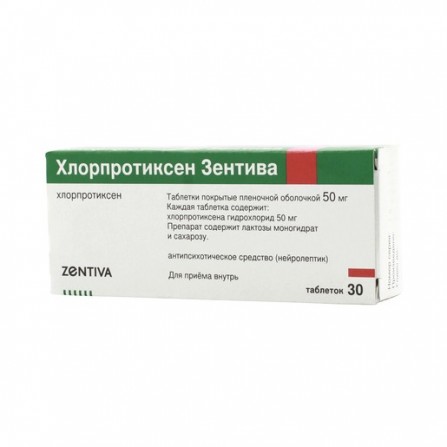Chlorprothixene coated pills 50mg N30
Condition: New product
998 Items
Rating:
Be the first to write a review!

More info
Active ingredients
Chlorprothixen
Release form
Pills
Composition
1 tablet contains: Active ingredient: Chlorprothixene hydrochloride 50 mg. Auxiliary substances: corn starch - 37.5 mg, lactose monohydrate - 135 mg, sucrose - 20 mg, calcium stearate - 3.75 mg, talc - 3.75 mg. 5 - 3.6594 mg, macrogol 6000 - 0.1333 mg, macrogol 300 - 0.9166 mg, talc - 2.4194 mg, titanium dioxide - 0.3423 mg, iron dye yellow oxide - 0.029 mg.
Pharmacological effect
Antipsychotic (neuroleptic), a derivative of thioxanthene. has antipsychotic, antidepressant, sedative, antiemetic effects, has alpha-adreno-blocking activity. It is believed that antipsychotic action is associated with the blockade of postsynaptic dopamine receptors in the brain. the antiemetic effect is associated with blockade of the chemoreceptor trigger point of the medulla oblongata. sedative effect due to the indirect weakening of the activity of the reticular system of the brain stem. inhibits the release of most hormones of the hypothalamus and pituitary. However, as a result of blockade of the prolactin inhibitory factor, which inhibits the release of prolactin from the pituitary, prolactin concentration increases. The chemical structure and pharmacological properties of thioxanthenes are similar to piperazine derivatives of phenothiazine.
Pharmacokinetics
Metabolized in the liver. Excreted mainly by the kidneys.
Indications
Chlorprothixene is a sedative neuroleptic with a wide range of indications, which include: psychosis, including schizophrenia and manic states, occurring with psychomotor agitation, agitation and anxiety, hangover withdrawal syndrome during childhood, alcoholism and drug addiction, hyperactivity, irritability, arousal, mentality, adult, mental illness, alcoholism and drug addiction; behavioral disorders in children; depression, neurosis, psychosomatic disorders; insomnia; pain (in combination with analgesics).
Contraindications
hypersensitivity to the components of Chlorprothixene, depression of the CNS of any origin (including those caused by alcohol, barbiturates or opiates), coma, vascular collapse, diseases of the blood-forming organs, pheochromocytoma.
Precautionary measures
Keep out of the reach of children.
Use during pregnancy and lactation
Contraindicated for use during pregnancy and lactation.
Dosage and administration
Psychoses, including schizophrenia and manic states. Treatment begins with 50-100 mg / day, gradually increasing the dose until the optimum effect is reached, usually up to 300 mg / day. In some cases, the dose may be increased to 1200 mg / day. Maintenance dose is usually 100-200 mg / day. The daily dose of Chlorprothixene Zentiva is usually divided into 2-3 doses, given the pronounced sedative effect of Chlorprothixene Zentiva, it is recommended to prescribe a smaller part of the daily dose in the daytime, and a large part in the evening. 3 doses, 500 mg. The course of treatment usually lasts 7 days. After disappearance of withdrawal symptoms, the dose is gradually reduced. A maintenance dose of 15-45 mg / day helps stabilize the condition, reduces the risk of developing another binge. In elderly patients with hyperactivity, irritability, agitation, confusion, 15-90 mg / day is prescribed. The daily dose is usually divided into 3 doses. In children, for the correction of behavioral disorders, Chlorprothixene Zentiva is prescribed at a rate of 0.5–2 mg / kg body weight. Depression, neurosis, and psychosomatic disorders. , energized, as an adjunct to antidepressant therapy or alone. Chlorprothixene Zentiva can be prescribed for neurosis and psychosomatic disorders, accompanied by anxiety and depressive disorders up to 90 mg / day. The daily dose, as a rule, is divided into 2-3 doses. Since taking Chlorprothixene Zentiva does not cause the development of addiction or drug dependence, it can be used for a long time. Insomnia. At 15 - 30 mg in the evening for 1 hour before sleep. Pain. The ability of Chlorprothixene Zentiva to potentiate the action of analgesics can be used to treat patients with pain. In these cases, Chlorprothixene Zentiva is prescribed together with analgesics in doses of 15 to 300 mg.
Side effects
Drowsiness, tachycardia, dry mouth, excessive sweating, difficulty of accommodation. These side effects, usually occurring at the beginning of therapy, often disappear as it continues. Orthostatic hypotension may occur, especially with the use of Chlorprotixen in high dosages. Headache, dysmenorrhea, skin rashes, and constipation are rare. Extrapyramidal symptoms are especially rare. Isolated cases of reduced seizure threshold, transient benign leukopenia and hemolytic anemia are described. With prolonged use, especially in high doses, cholestatic jaundice, galactorrhea, and appetite may occur. body mass.
Interaction with other drugs
With simultaneous use with anesthetics, opioid analgesics, sedatives, hypnotic drugs, anti-psychotic opticians, with ethanol, ethanol-containing drugs, the inhibitory effect on the CNS is enhanced. action.When used simultaneously with agents that cause extras iramide reactions, possible increase in the frequency and severity of extrapyramidal reactions; with levodopa - suppression of anti-parkinsonian action of levodopa is possible; with lithium carbonate - pronounced extrapyramidal symptoms, neurotoxic effect are possible. If used concurrently with epinephrine, blockade of alpha-adrenergic effects of epinephrine and the development of severe arterial hypotension and tachycardia as a result of this can occur. with quinidine - possibly strengthening the inhibitory effect on the heart.
special instructions
It should not be used for epilepsy, a tendency to collapse, parkinsonism, heart defects in the stage of decompensation, tachycardia, atherosclerosis of cerebral vessels, expressed impaired liver function and kidney problemsin old age. If it is necessary to use Chlorprothixene, the risk and benefit of treatment should be compared in patients with chronic alcoholism, cardiovascular diseases (the risk of transient arterial hypotension is increased), Reye's syndrome, and glaucoma or susceptibility to it, gastric ulcer duodenal ulcer, urinary retention, Parkinson's disease, epileptic seizures, hypersensitivity to other thioxanthenes or phenothiazines. When Chlorprothixene is used false positive results of immunological pregnancy test using urine, as well as false positive results of urinalysis for bilirubin. Avoid alcohol consumption during treatment. Impact on ability to drive motor vehicles and control mechanisms. During the period of treatment, you should refrain from engaging in potentially hazardous activities that require increased attention fast psychomotor reactions.



